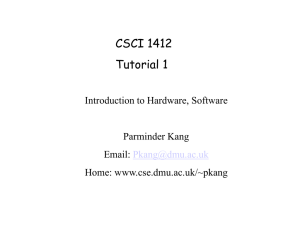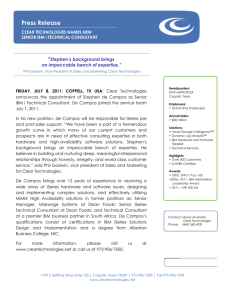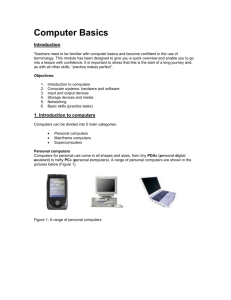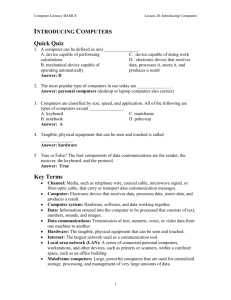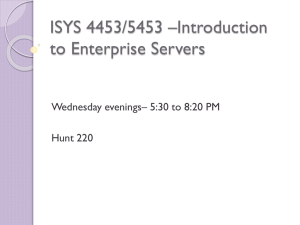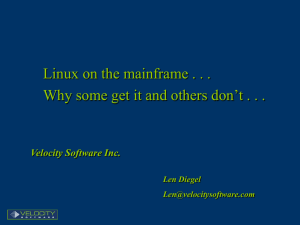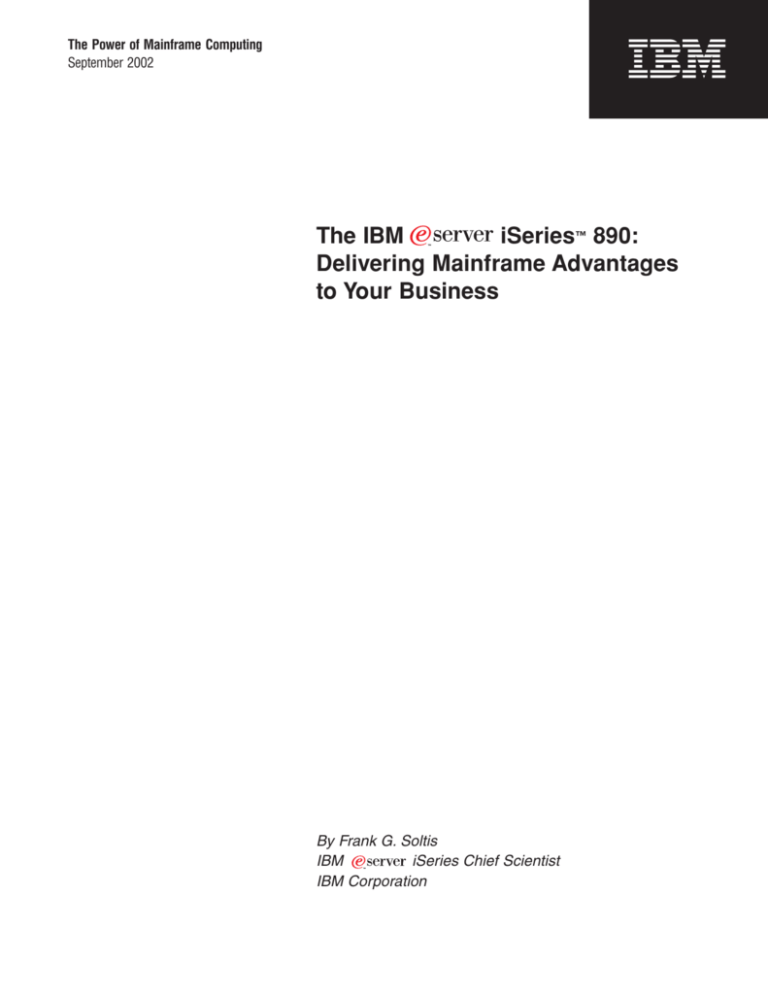
The Power of Mainframe Computing
September 2002
The IBM
iSeries™ 890:
Delivering Mainframe Advantages
to Your Business
By Frank G. Soltis
IBM
iSeries Chief Scientist
IBM Corporation
i890: Delivering Mainframe Advantages to Your Business
Page 2
Contents
2
The Mainframe Conundrum
3
What’s so Special about
The IBM ~ iSeries 890, the newest member of the iSeries product line, is
referred to as a mainframe. Why? While it delivers all of the traditional iSeries
advantages such as simplicity of operations, leveraged investment, reliability and
security, it also delivers the key business benefits, high performance and
technology that have long been associated primarily with mainframes.
Mainframes?
4
Leveraged Investment
5
Flexibility
6
Computing Power and I/O
Performance
7
High Availability
7
High Security
8
Mainframe Capability, iSeries
Simplicity
3-8 Sidebar — Why Categories are
Important
This paper examines what those mainframe benefits are, why they’re
important to your business, and how the i890 embodies them through the
application of advanced IBM ~ technology.
The mainframe conundrum
The term “mainframe” carries with it strong imagery. Mainframes are the big
iron, the huge computers that have driven the largest corporations for decades.
Mainframes are very powerful and extremely reliable, built specifically to handle
large-scale, mission-critical business applications where downtime means
significant losses. Mainframes are stable, often running traditional applications
year after year without so much as a hiccup. Mainframes also are where
advanced computing technologies such as clustering first were developed.
For many organizations with limited IT resources, however, the deployment of
a mainframe has been thought of as beyond reach. The perception has been that,
as desirable as mainframe computing attributes are, the challenge of moving to a
mainframe might be too great.
With the introduction of the i890 server, this has changed. The i890 server
effectively combines true mainframe-class capabilities and power with
established iSeries advantages that have made iSeries servers so popular with
small and mid-sized businesses...those same businesses that have thought
mainframes were not for them.
iSeries servers have always been designed, first and foremost, to deliver
simplicity. They provide tremendous ease of management, application flexibility
and low total cost of ownership through an innovative integrated design, simple
centralized systems management and unique storage and memory sharing
architecture. These are the key attributes demanded by organizations facing cost
and IT resource pressures. The iSeries also benefits from IBM ~
iSeries 890: Delivering Mainframe Advantages to Your Business
Page 3
SIDEBAR: Why categories are important
Why is choosing to call the i890
server a mainframe significant? It
has to do with how IT architectures
are perceived... or in the
mainframe’s case, misperceived.
Many business customers
(including iSeries customers) tend
to dismiss the very idea of
deploying a mainframe as
impractical. Mainframes are too
large and complex, the thinking
goes, with layer upon layer of
hardware and software to integrate
and manage. Images of big boxes,
big data centers and big budgets
abound.
technology (see sidebar), which brings advanced technologies originally developed
in other server families to bear.
Each new iSeries server has delivered increasing levels of computing
performance, capacity, scalability and expandability. Where the i890 breaks new
ground is in the outstanding performance provided by its new processors. This is
one of the advancements that places the i890 firmly in the mainframe class, but
it’s not just processing power that’s important. Mainframes deliver other business
advantages, and the i890 server shares them as well.
What’s so special about mainframes?
Mainframes have always held a key role in business computing. No other
computing platform can deliver the level of high-utilization, transaction-intensive
computing performance — the kind of computing employed by mission-critical
business applications — that a mainframe can.
But what is a mainframe, exactly? Mainframes are not necessarily the
“biggest” or “fastest.” In fact, there probably is no precise definition for the
mainframe that satisfies everyone. Perhaps the best way to define the mainframe
is to look not at the hardware, but at what it’s built to do...and at the advantages
it offers.
In its simplest form, mainframes are data and transaction servers able to
handle a variety of job types simultaneously at very high utilizations, as opposed
to the numerically-intensive, relatively low transaction type of computing for
which supercomputers are built. But a mainframe goes beyond just a server: it’s
a set of valued attributes designed specifically to deliver the kind of performance
required for high-end business computing.
How does the i890 server fit into this concept? As noted in the sidebar, IBM’s
approach is to spread technologies between different computing platforms. Most
notable is the ongoing percolation of high-end, mainframe-class technologies that
originated in the IBM ~ zSeries™ server and its predecessors to the other
platforms. Eventually, so much of this advanced, mainframe-class technology is
built into a given server that it makes sense to apply the mainframe label itself.
With the i890 server, that point has been reached.
iSeries 890: Delivering Mainframe Advantages to Your Business
Page 4
SIDEBAR - continued
This view of the mainframe is
misinformed. Mainframes have
continued their advancement and
are not what they once were.
Today’s mainframes are easier to
manage and more cost-effective
than the outdated, stereotypical
image would have one believe. In
Here are some of the key traditional attributes of mainframes, why they’re
important in a business context and a look at how the i890 server stacks up:
Leveraged investment — Computing architectures that do not provide backward
compatibility are poor business choices and can ultimately saddle a business with
a mission-critical legacy application running on a dead-end platform. Stability is
absolutely vital in a business environment, and the more mission-critical the
application, the more important it becomes. Compared to the knowledge that the
platform will still be around in five or even ten years, serving the business’ needs
as well as it does today, all the fast processors and monstrous disk drives in the
world fade to insignificance.
addition, mainframe-class
technology is now appearing in
systems that have not traditionally
been thought of as mainframes,
such as the famously easy-tomanage iSeries product line.
One of the hallmarks of IBM mainframes over the years has been their ability
to continuously evolve with the newest technologies and the newest application
environments while still leveraging customer investments in application software
and training. A customer could have written an application or a routine back in
the 1960s and that code, even if it was written in assembler language, can still
run today.
The mainframe has a “secret weapon” that it uses to support new application
or programming environments that become important to mainframe customers:
microcode. Through it, the mainframe has been able to continuously change the
underlying architecture to support new environments. Because these microcode
changes are usually additions, older environments are also supported by the new
architecture.
The iSeries platform has a similar secret weapon to maximize customer
investments in application software and personnel training, called the System
Licensed Internal Code (SLIC). Like the microcode used in mainframes, SLIC
allows the architecture of iSeries servers to evolve to meet new needs of
customers. New technologies and new application environments are constantly
being added to enhance the system architecture. Yet, like the mainframe, older
environments are also supported by the new architecture.
As a result, the i890 server is fully capable of running older applications if
needed, right alongside newer applications...just as mainframes do.
iSeries 890: Delivering Mainframe Advantages to Your Business
Page 5
SIDEBAR - continued
This movement of technologies
across old dividing lines goes to
the heart of the IBM ^
concept. Accordingly, IBM crosspollinated its server technologies
by launching the IBM ^
product line.
Leveraging customer investment also means being able to easily scale or
upgrade the system to meet new demands. One way that IBM mainframes
accomplish this is by allowing the simple addition of new machines to existing
clusters. The i890 uses a similar approach, with the ability to directly attach
multiple physical servers together via a high-speed link, while still managing
them as a single system. In addition, IBM has created a clear upgrade path
within the iSeries that allows customers to upgrade and scale their systems over
the long term without having to start over. The i890 server also offers Capacity
Upgrade on Demand, in which additional processing capacity is preinstalled, but
paid for only when activated.
Flexibility — Flexibility in a business sense means not being tied down to a
particular application or operating environment. Mainframes have supported
multiple operating systems and multiple, mixed workloads since the beginning.
This is a key mainframe capability that enables businesses to consolidate
operations onto a single system while sharing resources...even shuffling them
between applications through advanced workload management technologies.
The i890 server, like zSeries mainframes, gives business customers wide
latitude in choosing, mixing and dynamically managing operating systems and
workloads. Native OS/400® applications (both interactive and client-server),
Linux®, ported UNIX® and even Microsoft® Windows® applications can all
coexist within the same server footprint. Thanks to logical partitioning (LPAR,
another technology that comes straight from mainframes) and IBM’s unique
Integrated xSeries™ Server and Integrated xSeries Adapter, a single i890 server
can fill the role of a room full of discrete servers running diverse operating
systems, all while sharing system management and hardware resources.
The flexibility of the i890 server is further enhanced through mainframe-like
dynamic workload management, which allows resources to be shifted from one
partition to another “on the fly,” without having to restart the system. This
dynamic workload management capability directly mirrors that of IBM
mainframes.
These attributes make the i890 server ideal for server consolidation, which has
the potential to further drive down ownership costs by reducing hardware
investment and consolidating management.
iSeries 890: Delivering Mainframe Advantages to Your Business
Page 6
SIDEBAR - continued
The sharing of IBM ^
technologies goes in both
directions. For example, advanced
mainframe-class technologies such
as logical partitioning (LPAR),
which enables processor capacity
to be divided into multiple virtual
systems, were brought out of the
mainframe camp and implemented
in other server lines such as the
i890. On the other side,
technologies such as simplified
systems management, a hallmark of
iSeries, have been propagated
upwards into the zSeries product
line.
Computing power and I/O performance — A central characteristic of mainframes
is high performance in a business context. “High performance” is often thought
to mean raw computational power, but for business uses the ability to move large
amounts of data through the system (input/output) is equally important.
Mainframes are not always the “highest performance” computers when
measured by narrow computational speed criteria. That distinction usually goes
to the supercomputers, which are designed to support very specific types of
applications that typically fall into the category of numeric-intensive computing.
For general-purpose business applications, however, the mainframe generally
comes out ahead in terms of computational power.
The POWER4™ processors used in the i890 server provide an interesting mix
of supercomputer performance and general-purpose computing. These exact
same processors power IBM supercomputers. Their role in the i890 server,
however, is to provide high performance in a general-purpose, businesscomputing environment. This is borne out by the benchmark records that have
been set by the POWER4 processors in the i890 server and the
IBM ~ pSeries™ 690.
Business computing, unlike scientific and technical computing, places a
premium on transactional processing, with high demands on bandwidth and
connectivity. An ultra-fast processor is useless if it wastes time waiting for the
rest of the system to catch up. For this reason, mainframes have always
emphasized a balanced system design in I/O performance and bandwidth
because of its central role in business computing. With a peak bandwidth of 205
gigabytes per second, the i890 server has the highest memory bandwidth in the
industry. No other computer, can match it.
The i890 server also offloads the I/O processing from the main processors to
hundreds of dedicated I/O processors, which frees the main processors for actual
computation and thereby further boosts I/O performance. This is clearly a
mainframe feature. Other systems generally use the main processors for both
application and I/O processing. In fact, there are only two major systems that use
this idea of intelligent I/O: the iSeries and zSeries mainframes.
iSeries 890: Delivering Mainframe Advantages to Your Business
Page 7
SIDEBAR - continued
The result is that old perceptions
and definitions need reassessment.
The dividing lines are increasingly
blurred: Mainframes are no longer
the complex, hard-to-manage
systems they once were. Midrange
computers no longer lack the
advanced, powerful capabilities that
have always made mainframes
desirable. Therefore, a business
that might otherwise have ruled out
mainframes (and the significant
business benefits they offer) in the
past should take a fresh look and
rethink those long-held beliefs.
High availability — Mainframe servers need to be available 24 hours a day, seven
days a week. Many businesses requiring a mainframe demand this level of
availability. It is small wonder then that some of the most available systems
anywhere are IBM mainframes.
IBM’s introduction of the Parallel Sysplex® (a collection of systems that
cooperate, sharing resources and allowing applications to communicate directly
with one another) provided a major leap forward in system availability. A
clustered approach, such as a Parallel Sysplex, uses redundancy and data sharing
to achieve the highest possible availability. Basically, this type of cluster can be
configured in such a way that there is no single point of failure.
The iSeries also provides high availability solutions, but with a slightly
different focus. Because most iSeries customers have only a single server, the
focus of the iSeries is to achieve the highest single-system availability. Of course,
iSeries cluster solutions are also available for those customers who need higher
availability than can be achieved with a single system.
High security — Hackers in movies are sometimes shown breaking into a
mainframe. In reality, however, this is rarely possible. The emphasis on security
has been paramount in the design of the mainframe from the very beginning.
The newest and most sophisticated security technologies have been introduced
into the operating systems over the years, such as digital certificates,
authentication, intrusion detection technology, the ability to protect LPARs from
one another and virtual private networks. Some security measures have even
been introduced through microcode enhancements. The goal has been to make
the mainframe as secure as it possibly can be.
Starting in the 1980s, IBM began shipping only object code (as opposed to
source code) for its mainframe operating systems. By hiding many of the internal
details of the operating system, it becomes more difficult for a hacker to find a
way to bypass the security. It also makes it very difficult to create a virus that
can be introduced into the system.
The iSeries product line subscribes to the same security philosophies. Since
the AS/400® was introduced in 1988, the details of OS/400 and SLIC have
iSeries 890: Delivering Mainframe Advantages to Your Business
Page 8
been hidden. This, along with the design of the system architecture, has made
the iSeries extremely secure and virus-resistant. And like zSeries servers, the
iSeries product line incorporates the latest security measures as they are
developed. Because of its outstanding record of security since introduction, there
are those who believe that the iSeries is today the most secure server a business
can buy.
Mainframe capability, iSeries simplicity
Now, for the first time, a business server is available that is among the most
powerful available, while also being among the easiest to manage and most costeffective to own.
Advanced IBM ~ technology is the key. The i890 server exemplifies the
intelligent application of technology with a clear business computing purpose. It’s
not a display of technology for the sake of technology. It’s the application of
advanced technology with the goal of increasing simplicity, capability and
performance while decreasing costs and management headaches.
What it means to business customers is the best of both worlds: true
mainframe-class functionality, performance, reliability, availability, security and
investment leverage combined with iSeries manageability, application flexibility
and low cost of ownership. It’s enterprise IT management made simple: high
tech, low stress.
© Copyright IBM Corporation 2002
IBM Corporation
Integrated Marketing Communications,
Server Group
Route 100
Somers, NY 10589
Published in the United States of America
9-02
All Rights Reserved
References in this publication to IBM products
or services do not imply that IBM intends to
make them available in every country in which
IBM operates. The information may be subject
to change without notice. Consult your local
IBM business contact for information on the
products, features and services available in
your area.
IBM, the IBM logo, the e-business logo, AS/400,
iSeries, OS/400, pSeries, Parallel Sysplex,
POWER4, xSeries and zSeries are trademarks
or registered trademarks of International
Business Machines Corporation in the United
States, other countries, or both.
Linux is a registered trademark of Linus
Torvalds.
Microsoft and Windows are trademarks of
Microsoft Corporation in the United States,
other countries, or both.
UNIX is a registered trademark of The Open
Group in the United States and other countries.
Other company, product, and service names
may be trademarks or service marks of others.
IBM hardware products are manufactured from
new parts, or new and used parts. Regardless,
our warranty terms apply.
This equipment is subject to all applicable FCC
rules and will comply with them upon delivery.
Information concerning non-IBM products was
obtained from the suppliers of these products
and does not constitute an endorsement of
such products by IBM. Questions on the
capabilities of the non-IBM products should be
addressed to the suppliers.
GM13-0169-00

